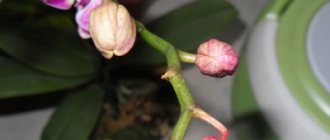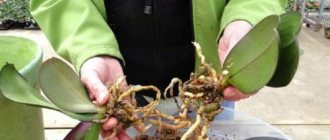What is this procedure?
Spraying is the process of applying pesticides in liquid form. In this case, it is aeration with water in order to prevent rotting and drying of the plant. It can be used to control diseases and pests, get rid of weeds and disinfect.
If you need to treat a plant, special solutions and suspensions are often used. The effectiveness of this method depends on how toxic the pesticides are and how long they last.
Does the plant need to be sprayed with water?
You can and should spray orchids with water. But after completing this procedure, you must definitely go over all the leaves and flowers with a cotton swab.
Otherwise, due to increased humidity, bacteria will multiply and various diseases may develop.
Remember that it is better to spray a little than to overdo it. It is better to keep the plants on a tray with a grid - this way the excess moisture will drain on its own and will not harm the plant.
Processing Features
Self-processing of indoor plants has a number of features that must be taken into account by any gardener. Otherwise, significant harm to the culture can be caused.
Stimulants and supplements
The spraying procedure carried out is not only ordinary, but also health-improving and stimulating. Orchids respond very well to such manipulations. You can see the first effect a few hours after the first treatment.
The most important thing is to follow all tips and recommendations during work, strictly follow the attached instructions and not exceed the maximum permissible dosage. If you plan to use fertilizers, then apply them to a minimum. This is required so that the roots do not get burned.
Preparations for pests
In addition to fertilizing, it is allowed to use insecticides for preventive purposes, which helps prevent a number of diseases and pests. Spraying is considered a method of control; if necessary, it can also be applied to orchids.
The work is carried out strictly according to the instructions that the manufacturer encloses with the drug being sold. When processing plants, it is recommended to use protective equipment. The plant is then sent to quarantine.
Attention! When working with chemicals, it is important to remember safety precautions.
Step-by-step instruction
The instructions for spraying an orchid are as follows:
The water should be soft. If it is too hard, boil it. If this is not done, the plant will have white stains from salts.- It is better to use a fine spray. If there are large drops on the leaves, then spraying should be stopped.
- The procedure must be carried out in the morning or afternoon. It is not recommended to do this in the evening, since moisture remaining on the leaves and in the axils can lead to the development of diseases.
- In winter, it is better to refrain from moisturizing, especially in cold weather. Otherwise, bacteria and fungus may develop.
- You should not spray the flowers - they will instantly become stained.
- You should avoid getting moisture into the growing point, as this can cause root rot.
A novice orchid grower should know that watering and spraying should be done according to a schedule and only when the plant really needs it.
What water to water orchids at home: quality and temperature
Often tap water is saturated with chlorine, calcium, magnesium and iron salts. During the period of active snowmelt in Moscow water, the taste of chlorine becomes especially noticeable, and the acidity index approaches 9 (we will add in parentheses that the quality of tap water, for example, in St. Petersburg is almost ideal for watering orchids).
Before deciding whether you need to improve the water for watering your orchids, check its acidity (or pH). The pH value is indicated by the symbol pH. It varies from 1 to 14. The lower the pH value, the more acidic the solution. Neutral solutions have pH = 7, acidic solutions have pH < 7, and alkaline solutions have pH > 7. You can measure pH for proper watering of orchids at home using special paper indicators impregnated with special organic dyes (so-called litmus papers) or using a pocket ionomer.
Depending on the pH value, substrates for growing orchids can be classified as follows:
- pH = 4.0-5.0 - very acidic;
- pH = 5.0-6.5 - acidic;
- pH = 6.5-6.8 - slightly acidic;
- pH = 6.8-7.2 - almost neutral;
- pH = 7.2-7.5 - slightly alkaline.
The pH value of the water that most orchids need to be watered should be in the range of pH = 5.5-6.8.
In addition to monitoring the chemical composition, it is also necessary to control the temperature of the water: watering and spraying orchids is carried out with water whose temperature is 5-10 degrees higher than the ambient temperature. Following this rule will save your plants from the appearance of bacterial rot.
Possible problems after
If this procedure is carried out incorrectly, it can lead to the development of various diseases:
- Corrupted by rot. Symptoms can be different and depend on local conditions, air humidity levels, watering intensity and room temperature. We list the following cases: brown rot, black rot, root rot, gray rot, fusarium rot.
- Withered leaves of a black hue. This is a signal that the plant is in great danger. This can cause anthracnose, powdery mildew, and leaf spot. If the disease is diagnosed in time, there is a chance to cure the orchid. But in most cases it is no longer subject to resuscitation and treatment.
- Scale insects, mites and aphids. They have a huge impact on the development of the plant. The most common are spider mites, whiteflies, slugs, thrips, and sucking parasites. Appear due to excessive moisture.
Problems and solutions
Improper spraying procedures can lead to:
- affected by rot - brown bacterial, root, gray or black;
- lethargic leaves with a black tint;
- the appearance of pests - scale insects, aphids, mites.
There are also a number of solutions to solve these problems.
Rot
Brown bacterial rot appears as watery, gray-brown spots. Over time, they darken and merge together. It is possible to save the plant only at the stage when the disease has just appeared. To do this, you need to remove the infected parts of the plant and treat them with copper-based preparations. If the disease is noticed at a later stage, then the flower cannot be saved.- Root rot affects the roots. It causes them to become soft and spoil, and the plant dies. For prevention, the plant should be planted in suitable soil. And if infected, treat the roots and soil with a 0.2% solution of topsin or foundationazole.
- Gray rot is dark spots on the plant covered with a gray fluffy coating. To combat it, fungicides are used and damaged areas are completely removed.
- Black rot appears as black spots on the orchid. In this case, it is necessary to remove the infected parts and treat the cuts with charcoal.
Withered leaves with a black tint
Indicates that the plant is in serious danger. This is how a wide variety of diseases manifest themselves. Treatment begins after determining which one we are talking about.
Pests
They appear in the form of aphids, scale insects and mites. Appears when there is excess humidity. It is necessary to reconsider the conditions of maintenance and watering. Treat the plant with insecticides.
- Aphid . To get rid of aphids, the plant can be treated with a soap solution or use special preparations. Perform the treatment 2 times at a certain interval.
- Shield . When scale insects appear, the plant is isolated from others. They can be removed from the plant manually, or using an ear stick soaked in alcohol using a pinpoint method. Next, the plants are bathed to wash off the sticky coating. The plant is placed in a very bright place for 2-3 weeks. You can also wash it with soapy water.
- Spider mite . If a spider mite is detected, treat the plant with a special preparation twice at intervals. If affected by root mites, remove the damaged areas of the roots. Treated with Fitoverm.
Do you want to have a healthy plant at home with beautiful, abundant flowering? Then follow all the rules of care, not forgetting about spraying . The main thing is to do it correctly, without harming the plant.
If you find an error, please select a piece of text and press Ctrl+Enter.
Source
Care during the flowering period
If flowers appear on the plant, follow these recommendations:
- Intensive watering. You can do it with a shower. The optimal temperature will be 35 degrees. There is no need to leave water at the growing point to prevent the plant from dying.
- At night, you need to keep the temperature at the right level.
- The plant cannot be replanted during this period.
- When flowering, it is allowed to fertilize in moderation.
- Do not move the pot from place to place, as this may affect the duration of flowering.
When the flowers dry out and turn black, they are cut off. The incision is made at the base. During the dormant period, it is better to refuse feeding or keep it minimal. In winter, watering is carried out once a month, however, spraying can be done more often. By providing such a plant with proper care, you can achieve proper and long-lasting flowering. You will find all the important information about the conditions of keeping an orchid in this article, and you will receive advice from experienced gardeners on caring for this beauty here.
Is it possible and how to spray an orchid?
Growing orchids in the current age of information technology is accompanied by an overabundance of contradictory information, which soon turns into myths. Often these stories do not have any basis, that is, they are groundless. Among them: various superstitions associated with roots and leaves, the need for frequent feeding or mandatory replanting of an orchid after purchase, fears of drafts, contraindications for spraying and much more.
However, if we turn to common sense, it turns out that spraying is, on the contrary, a very beneficial procedure for the health of the orchid. Of course, it’s unlikely to be possible to recreate the tropics in an apartment by constantly spraying the room with a spray bottle, and is it really necessary?
However, in this way it is possible to sharply increase the air humidity around the orchid , thereby increasing the efficiency and flow of the photosynthesis process, which in turn has a beneficial effect on the development and growth of the plant.
Spraying is a very useful procedure for orchids.
Orchids can be sprayed several times a week. The frequency of how often a plant needs to be sprayed depends on the conditions, weather, microclimate around the plant, planting method and other factors. In hot weather, for plants fixed on blocks, the frequency of spraying can reach up to several times a day , starting in the morning and during daylight hours.
Orchids in nature mainly receive moisture from the air, so they really like spraying and serve as an imitation of natural conditions.
Technology
In this section we will determine how to properly spray orchids:
- The spraying procedure is carried out using a spray bottle . It is advisable to use a device that produces a mist stream in the form of a mixture of air and tiny droplets of water;
- spray plants individually or by grouping them in a bathtub/pallet or just on a windowsill . Direct the jet obliquely, from bottom to top, trying to reach the lower half of the leaf blade;
- The water should be used soft, purified, with a minimum content of dissolved salts . It is best to use rain or melt water (if the environmental situation at the collection site allows it) at room temperature or 2-3 °C higher;
- Time: preferably in the morning or early afternoon.
Attention! It is not recommended to spray plants in cloudy weather or if the air temperature is below 20-22 °C. Otherwise, the combination of moisture and cold can cause mold and rot.
After spraying, the plant should be covered with a layer of water mist; it should not be allowed to drip , and stagnation of moisture in the axils of the leaves is completely unacceptable. This can also cause rot and infection to develop. If moisture accumulates in the outlet, blot it with a napkin or paper towel.
Be sure to remove moisture from the leaf axils.
In hot weather, the combination of spraying and direct sunlight should also be avoided . A drop on a leaf acts like a magnifying lens and can cause burns to the surface of the leaves and pseudobulbs. Although at high temperatures the moisture will evaporate much faster than a burn can occur, but still.
Interesting video
Watch the video about whether you need to spray an orchid and how to do it correctly:
This exotic flower is really capricious, but it’s still worth trying to grow it at home. We will help you figure out what to do with it after purchasing it and where it is best to put it, how to care for it in autumn and winter, as well as how to properly grow, replant and prune it.











